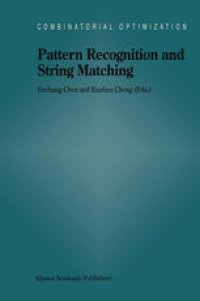
Ebook: Pattern Recognition and String Matching
- Tags: Combinatorics, Artificial Intelligence (incl. Robotics), Data Structures Cryptology and Information Theory, Statistical Physics Dynamical Systems and Complexity
- Series: Combinatorial Optimization 13
- Year: 2002
- Publisher: Springer US
- Edition: 1
- Language: English
- pdf
The research and development of pattern recognition have proven to be of importance in science, technology, and human activity. Many useful concepts and tools from different disciplines have been employed in pattern recognition. Among them is string matching, which receives much theoretical and practical attention. String matching is also an important topic in combinatorial optimization. This book is devoted to recent advances in pattern recognition and string matching. It consists of twenty eight chapters written by different authors, addressing a broad range of topics such as those from classifica tion, matching, mining, feature selection, and applications. Each chapter is self-contained, and presents either novel methodological approaches or applications of existing theories and techniques. The aim, intent, and motivation for publishing this book is to pro vide a reference tool for the increasing number of readers who depend upon pattern recognition or string matching in some way. This includes students and professionals in computer science, mathematics, statistics, and electrical engineering. We wish to thank all the authors for their valuable efforts, which made this book a reality. Thanks also go to all reviewers who gave generously of their time and expertise.
This volume is the most comprehensive one in its field. It is a collection of 28 state-of-the-art articles contributed by experts of pattern recognition, string matching, or both. It contains fundamental concepts and notations, as well as reports on current research with respect to both methodology and applications. In particular, it includes string matching related techniques for structural pattern recognition. It also explores many applications of pattern recognition strategies to image segmentation, intrusion detection, handwriting recognition and others.
This book is a good reference tool for scientists who depend on problems in pattern recognition and string matching. Target readers include researchers in computer science, statistics, mathematics, and electrical Engineering, as well as students. It is suitable for both specialists and uninformed readers.